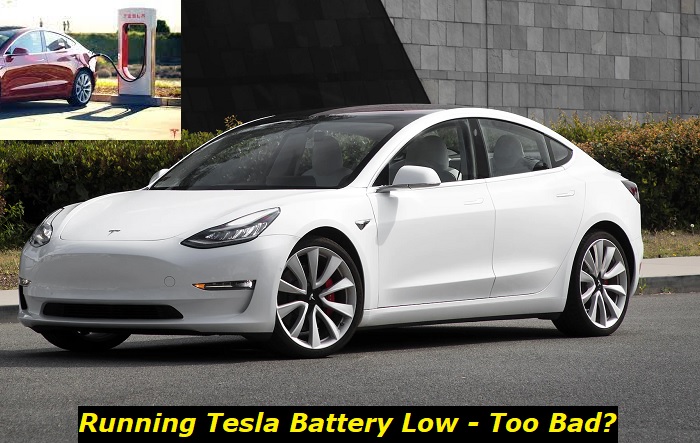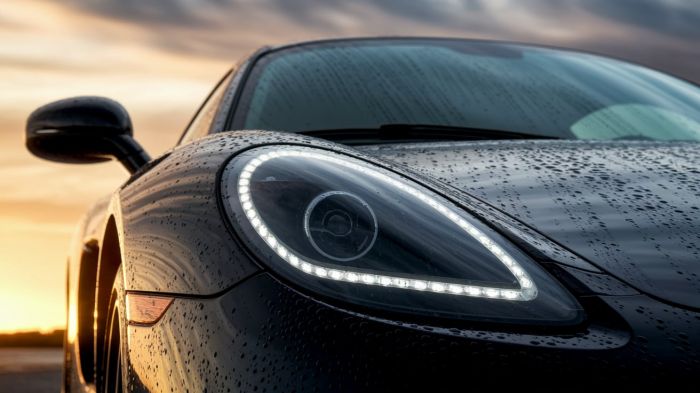Yes. If you make it a practice, it is bad for your battery. When you try to get your Tesla battery below 20% habitually, you risk a few percentages of reduced lifespan in your battery. For a Tesla owner, going beyond this point is very unlikely. You will become bombarded with range anxiety alerts. Going 10% is deliberately ignoring the warnings from your Tesla vehicle.
Most EV car owners should know the 80/20 percent battery rule to keep their batteries healthy.
So, if you want to know the consequences of using up your battery charge up to the last drop, think again.

About Tesla Batteries
For the record, Tesla conveniences its owners with many features that protect its battery. And up to today, Tesla batteries remain ahead. Other EV cars are trying to scale up but cannot catch up with the advancement of Tesla batteries. And while Tesla is working to hits its 4680-batteries annual goal production, its current 1865 and 2170 still pack promising features, including high energy density.
Although it takes an enormous effort, we can say that it is not worth killing your battery. Tesla battery replacements range from $13,000 to $20,000 depending on the model. But it is still unlikely that you need to replace your battery if you keep it in good health. According to Elon Musk, Tesla CEO, your Tesla battery can run 300,000 to 500,000 miles.
What is Considered Low on Tesla Battery?
The level at which a Tesla battery is considered low depends on several factors, including the battery condition, your vehicle model, and its age. For most electric vehicles, going lower than 20% is already critical.
For Tesla batteries, passing through 10% is critically low-level and is a deliberate tolerance for the driver. Tesla has smart features that remind the driver constantly that the battery needs charging. Also, Tesla vehicles come equipped with range estimators that tell how much farther they can go and at a range of speed.
For this reason, it's very unlikely for Tesla drivers going past beyond the critically low level except by deliberately trying to squeeze all its juice.
What Happens When Tesla Battery Goes Low?
1) The battery icon color changes
You can find the range and battery icons on the touchscreen display in the top left of the monitor. The green battery indicator will turn yellow when the battery goes down 20%. If it goes beyond the critical level, it will turn red. If you get past this point, it's on its way to squeezing the last juice.
2) Range anxiety warning
Range anxiety warning is a safety feature that alerts the driver as soon as the system finds that the vehicle may not have enough range to make it to its destination. These alerts activate when the battery reaches 20% low. The dashboard will display warnings, including the estimated range and battery status. You will receive a display and sound alert.
Your Tesla knows when your battery is about to go critically low. It knows and will tell you how much speed or which speed range it could run to with that battery level. This point is where your Tesla will control your speed, And you may notice your vehicle is going slow.
Your vehicle knows where you are and where is the nearest charging station. It can recommend a route adjustment. It is so intelligent that it knows you are bringing the vehicle where you cannot charge your battery.
3) You can still drive your Tesla for a few miles
Your Tesla battery has power reserves. This feature only means you can run it up to a couple of ten miles within a certain speed when the range goes down to zero. It's enough to park your vehicle at bay and call a tow truck or roadside assistance.
4) Performance reduces
You will notice your Tesla slowing down. If you went beyond this point, you must have deliberately ignored alerts from Tesla. Before this, your Tesla has told you where you can go to charge your battery. As it predicts you are not heading to the nearest charging station. It will suggest reducing your speed.
Additionally, it will turn off other working electrical components to save battery:
- Air conditioning & heating systems
- Power audio system
- Window and door locks
- Seat heaters
- Autopilot features
- Regenerative breaking
5) You need to call a flatbed tow truck
Tesla's low ground clearance is not advisable for an ordinary truck that tows a vehicle with two wheels. Its undercarriage design may damage easily, including its electronic components, battery, and charging systems.
Since most Teslas are All-Wheel-Drive, you need a flatbed truck that tows all four wheels. It safely handles electric motors and drivetrain components during transportation.
Tesla Battery Empties to Zero: The Consequences
- Your battery warranty may be void
All Tesla batteries have eight years of warranty coverage, which is about 100,000 to 120,000 miles. However, not following their charging procedures may void your warranty. Having your battery near or at zero percentage is not an accident. The system has repeatedly warned you and ignored it deliberately is not neglect on their part nor a cause of an accident.
- It may go into deep sleep mode
Tesla uses a battery-protection feature when the battery goes near or at zero, where it disconnects the battery from the electrical system. While you can still drive your Tesla at zero, it is not advisable to be in this state. Your battery can go into a long hibernation. This protection feature prevents the battery and other electronic components from getting damaged.
In this mode, the battery will shut down and automatically disconnect from the electrical systems. For this reason, you may find your car unresponsive. It will not communicate with your keyfob.
Most electrical components will disconnect from the battery. These components include the electric motor, onboard computer, inverter, and charger. Your 12V battery, which connects to other components such as lights and radio, will be affected.
- It may not charge for quite some time
In most cases, it would take months for the Tesla battery to be in deep sleep mode. You cannot charge or discharge the battery in this state. However, remember that keeping your Tesla battery unplugged for a long time could damage your battery.
If you need to keep your battery unplugged for a long time, it should at least have around 50% of charge. Roadster batteries can keep this long time undisturbed and still be in good shape for two months before being discharged. Model S batteries could keep unplugged at 50% and discharged within twelve months. The good thing about the new batteries is they will not allow the batteries to go below 5%.
How Does a Habit of Driving with Low Charge Affect your Battery?
1) Reduced Battery Life
Running your Tesla regularly on low battery and up to its maximum capacity is not healthy. As Lithium batteries work efficiently and healthily at 80/20 percent in EVs, pushing them to their capacity only accelerates the battery to degradation.
When constantly used up to below 5% or near 0% battery charge, the chemical reactions inside the battery become more active, stressing the battery and adding wear and tear.
2) Risk of Battery Malfunction
Although Tesla batteries have an intelligent design that allows onboard computer systems to protect them, the constant pushing of the battery to its limits is not only stressful but may also cause risks of different battery malfunctions.
It can cause battery failures such as short circuits, charging errors, fast & parasitic draining, and under & overcharging.
Although it would take more effort to kill a Tesla battery, the risk is there. And constantly challenging its capacity would be equivalent to reduced miles on your battery.
3) Longer charging times
Slow charging is a result of improper charging practices and battery degradation. It is also a result of heat build-up. Heat builds up when the batteries are critically low because it is trying to meet the capacity it needs to run. For this reason, Tesla discourages the frequent use of Superchargers.
When the charge is too low, heat may build up. Excessive temperature is damaging to the cells of the battery. Although Tesla batteries have their way of protecting themselves from this malfunction, you can also exert your effort in protecting the batteries.
4) Wrong calibration
Wrong calibration can be a result of improper charging habits. Challenging your battery to its maximum capacity every time may lead to inaccurate calibration, where it displays the reading of range, temperature, or state of charge. The Battery Management System (BMS) handles all these readings and analyses the information to provide the user with the necessary information for routing.
But constantly challenging your battery capacity not only leads to degradation but may also damage internal components, which could affect the accuracy of information displayed or analyzed by the BMS.
What Can You Do if Tesla Battery Runs Out of Battery?
You do not have to challenge your battery's capacity and let it squeeze to its last drops. Many ways can solve the issue when the battery goes critically low. Park your vehicle in the service bay and figure out which of the following you can do,
- Go to the nearest Tesla Supercharger
Your vehicle knows where the nearest superchargers are. Ask your Tesla the way to go there.
- Plug in your charging cable to any electrical outlet
Your Tesla only needs an electric plug to use the charging cable. It pays to bring your charging cable at all times.
- Avail of Tesla Roadside Assistance
Tesla Roadside Assistance is generally free when covered by warranty. If there's a Tesla Roadside Assistance nearby your location, call them.
- Call a towing company (with towing experience with Tesla)
As said earlier, call a towing company with a flatbed towing truck. It will help you protect the electronics in your vehicle.
- Call a mobile charging company
If there's a mobile charging company near your location, you do not have to tow your vehicle. Park it on the bay area of the road and charge your tesla battery with a mobile charger.
Final Thoughts
It is not worth risking your battery to its maximum capacity. A lot of owners say, you are paying for Tesla battery's advanced technology, and you should maximize it. Check back your owner's documentation and see Tesla's recommended charging habits.
They have included how you might void the warranty if you intentionally do not follow their recommendations and get your battery to near or zero battery charge. The 80/20 battery rule works for most Lithium batteries. And it is, by far, the most efficient way to keep your Tesla battery healthy.
About the authors
The CarAraC research team is composed of seasoned auto mechanics and automotive industry professionals, including individuals with advanced degrees and certifications in their field. Our team members boast prestigious credentials, reflecting their extensive knowledge and skills. These qualifications include: IMI: Institute of the Motor Industry, ASE-Certified Master Automobile Technicians; Coventry University, Graduate of MA in Automotive Journalism; Politecnico di Torino, Italy, MS Automotive Engineering; Ss. Cyril and Methodius University in Skopje, Mechanical University in Skopje; TOC Automotive College; DHA Suffa University, Department of Mechanical Engineering






Add comment